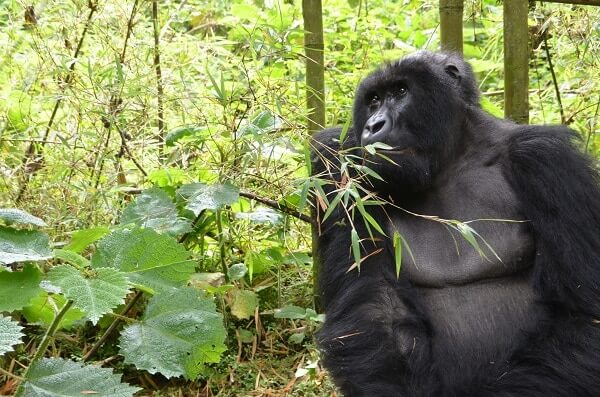As the rising sun begins to colour the savannah grasslands of the Akagera National Park in Rwanda, we spot a herd of antelopes grazing under acacia trees, perhaps thinking how to survive another day without being the prey for a lion or a leopard. This expansive sanctuary – often referred to as Rwanda’s Serengeti – is another home to Africa’s Big Five, which besides the two carnivores includes rhinos, elephants and buffaloes.
We later locate several buffalos and elephants plus zebras, giraffes, hyenas and hippos, unfortunately not lucky enough to trace the rhinos and the predators. This doesn’t disappoint me too much, because I am in Rwanda chiefly to see the mountain gorillas – one of the world’s most endangered species – in their own wild habitat, chasing other wildlife coming in as a bonus.
Gorillas are Rwanda’s key attraction.

One-third of the planet’s last lot of mountain gorilla population, currently just over 1000, hide in their Volcanoes National Park, located at the foothills of a chain of volcanic mountains in the north-eastern part of the country. The rest lives in neighbouring Uganda and Congo. A few decades back, they were nearing extinction due to illness and poaching.
The species has survived thanks to the great efforts of animal lovers like American Dian Fossey, who spent most of her life in Rwanda working with these mysterious animals. She was sadly murdered in Rwanda in 1985 but her good work still keeps going through the Dian Fossey Gorilla Fund. (To know more about her life and work, check out the well-known Hollywood film Gorillas in the Mist.)
Slogging through the mist-engulfed thick jungle to spot the gorillas, who tend to live in big groups comprising of males (called silverbacks because of the silver lining in their backside), females as well as juveniles, can be described as a life-changing experience; particularly when watching their daily routine from close proximity. They are pretty harmless and used to seeing humans, but still the rangers insist on a 7m distance from them.

Currently, there are 12 groups which are habituated to humans and can be visited. Each group is made up of some 15 to 20 members. At the parks, headquarter in Kinigi, a small town near the volcanic mountains, trekking permits for only eight visitors per group are issued each day. Time allowed with the gorillas is limited to just one hour, to minimise human interaction, the spreading of infections and undue stress on this endangered species.
The permits are nor cheap, costing US$ 1500 per person but anyone who has embarked on this will possibly say every dollar spent is worth this once-in-a-lifetime experience.

The physically demanding trek can vary from at least one to up to eight hours depending on the group’s location within the vast sanctuary. Luck favours us as we find ours – the Sabyinyo group, one of the park’s oldest – after labouring for an hour and a half.
I am enthralled from the very first sight: the world’s largest primates, around 15 of them, in an open area doing all sorts of humanly things in front of us – rolling, jumping, somersaulting, eating bamboo stems, making faces, scratching, even fighting. Nothing unusual for such behaviour as they share 98% of their DNA with us. Resembling the fabled King Kong, a large 6-foot male sits atop a rock, keeping an eye on everything around. Our guide tells he is 47-year-old Guhonda, the head of the group and possibly the oldest gorilla in Rwanda.
Besides gorillas, the other thing that people associate with Rwanda is the brutal genocide of 1994 in which some million people were killed in just 100 days.
However for 12 million Rwandans today it’s the past from which they have moved on to make their nation one of the most progressive in the continent. Today they don’t talk about their individual ethnicity, all proudly proclaiming themselves as Rwandans.
There are other things that are capturing the nation’s interest domestically, such as the government’s unique initiatives like banning plastic bags, using drones for essential medical supply and hosting a major conservation-focussed festival, the Kwita Izina, to name baby gorillas born during the year.
Among all the initiatives, what strike me most impressive is Umuganda, a community event held every last Saturday of the month when all Rwandans above the age of 15 are voluntarily encouraged to get involved with some social welfare and public works. According to a local, this program brings the community together, increases social cohesion, saves some government funding and inspires all to work towards a common agenda. I wish this inspirational initiative cab be adopted in other countries too.

The results from the good work of the government and the people are noticeable throughout Rwanda, which is a very welcoming and safe destination for travellers. The urban quarters are clean and green, in particular, capital Kigali which with its enchanting mix of new and old, captivates visitors.

TRAVEL NOTEBOOK
Getting There Star Alliance member Ethiopian Airlines (www.ethiopianairlines.com) have flights from Singapore to Kigali via Addis Abba
Accommodation There are several hotels of international standard throughout Rwanda; in Kigali the plush Serena Hotel (www.serenahotels.com) is a good choice.
Visa For all nationalities, 30-day visa on arrival in Kigali is available upon payment of US$ 30
Currency Rwandan Franc US$1U = 900 RWF
Language English and French are widely spoken in addition to local dialects
Read also: Lebanese spread










